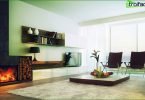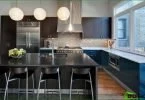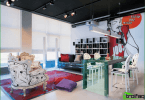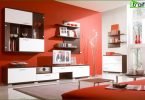DIY LED lighting
The pace of distribution of LED lighting in various spheres of life is growing every day. It captures more and more new areas of application of domestic and industrial nature. But it all started only with emergency and local lighting. Now you can easily install LED lighting with your own hands, using it both for decorative purposes and as the main lighting.
Content
- Sober calculation is the basis of success
- Selection of power supply for LED strip
- Calculation of the number of LED lights
Sober calculation is the basis of success
Selection of power supply for LED strip
LED tapes are produced in rolls of 5 m length, from 30 to 120 pieces of LEDs can be installed in each meter. It is not necessary to use all five meters. If you plan to highlight a smaller area, you can cut to the required length. If only anywhere, of course, it is impossible to cut. The cutting ratio should be 3 LEDs, most often the places of possible cutting are indicated by the manufacturer.
LED strip can not be connected directly to the network, only to the power supply. To select the power source of the required power, you need to know the total power consumption of the entire tape used.
We give an example of calculation:
We purchased the SMD 3528 tape. Its length is 5 m, the operating voltage is 12 V, the number of LEDs in one meter is 60 pieces, and the power consumption is 4.8 W / m. In other words, every meter of our tape consumes 4.8 watts. All these parameters are indicated on the tape itself or on the packaging..
The length of the area that we want to illuminate is 7 m. Therefore, one tape is not enough. We buy another cassette 5 m long and cut off from it 2 m, which we need.
Tape power consumption: Ptotal = Pm * L = 4.8 W / m * 7 m = 33.6 W;
Where,
Ptotal – total power consumption of the entire tape;
Pm – power consumption of one meter of tape;
L – tape length.
Total, the total power consumption of the tape was 33.6 watts. But to ensure the correct operation of the power supply, it is necessary to make a power reserve of 20%.
P = Ptotal * kz = 33.6 W * 1.2 = 40.32 W;
Where,
P is the required power of the power supply;
kz – safety factor (20% – in this case).
Now, according to the catalog of power supplies for LED strips, you need to choose one whose power is close to 40.32 W, but not lower.
Calculation of the number of LED lights
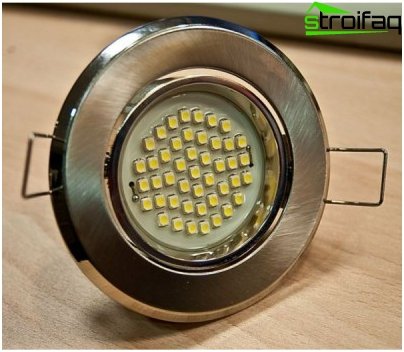
LED downlight can be used in suspended ceilings
LEDs have ceased to be used only as a decorative backlight. New technologies for the production of heavy-duty LEDs allow them to be used as the head lighting in a house or apartment and even in production.
The calculation of LED lighting in this case is made taking into account SNiPs, SanPiNov and other regulatory documents in order to provide comfortable conditions for a stay, life activity or work process in the room.
To calculate the number of LED lamps and the distribution of illumination, you can use special programs that are freely available for download on the Internet, for example, DIALux.
If exact data are not needed, you can try to do the calculations yourself – semi-empirically. First, we determine what we want to illuminate, instead of which lamps we already have, we will use LED ones. For each task, different lighting fixtures will be required: whether it is floor lighting, head lighting in a room, furniture or a false ceiling lighting.
For calculations, we need only one parameter – the luminous flux. This is a kind of brightness, light intensity, measured in lumens (Lm). The manufacturer must indicate the value of the luminous flux on its products, including LED lamps. We will calculate based on the fact that a 100 W incandescent lamp shines for approximately 1200 – 1300 Lm. For example, to replace a light bulb in a 60 W toilet, you will need to find an LED lamp with a light output of 600 – 700 Lm.
If the information on the package is not enough, you can perform calculations based on the power of the lamp. Most often, LED lamps consume from 5 watts to 12 watts. In this case, the approximate luminous flux per 1 W is 50 – 80 Lm. Maybe more, but we will take as a minimum – 50. To illuminate a room of 18 m2, 2500 Lm are needed. Divide by the minimum possible luminous flux of 50 Lm per 1 W. We get 50 watts. That should be the total power of LED lighting in the room. But how to choose: 10 lamps of 5 watts each, scattered evenly throughout the room, or 4 powerful lamps of 12 watts, – you decide.
LED Lighting Design
Such an important aspect as design is best left to professionals. And not only because it is their daily bread, but because they will have to face a number of difficulties. The wiring and lighting project of a house or apartment is not required to be changed, because the load on the network will not increase, but decrease. The complexity of designing LED lighting is associated with the technical and optical characteristics of LEDs. For example, light reflection, the angle of light emission, operating temperature, and luminous flux are extremely important, and such nuances as the color of walls and ceilings can dramatically affect the comfort of lighting.
Do it yourself
Installation and connection of LED strip
Determine how long the plot we want to illuminate with tape. If it is more than 5 m, buy the required number of cassettes and cut off the missing segment. With one power supply, a maximum of 15 m tape can be used (3 cassettes).
Then solder the wires between the segments. We put contact lugs on the ends of the wires to improve the quality of the contact between the wire and the power supply. Insulate the wires with a heat shrink tube.
Glue the tape to the surface. To do this, remove the protective coating from the self-adhesive side and apply to the base.
It remains to connect to the power supply. And here there are several nuances:
1. If the power supply for the LED strip is not too large, you can connect it without any questions and hide in the structure so that it is not visible.

2. If we use a powerful tape of large length, for example, 10 m, a power supply for it needs 100 watts. It is very heavy, it is impossible to hide it in a suspended ceiling. Therefore, it would be more expedient to use two blocks of lower power for two tapes.
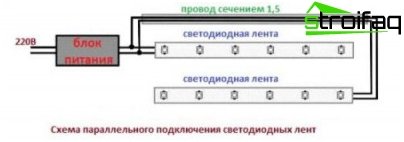
Scheme: Parallel connection of two tapes to one power supply
3. If the tape length is large (10 m), while the power supply is not too large, you can connect two tapes in parallel. This method has several advantages. The fact is that with the passage of current through a strip 10 meters long, the first LEDs will always be too overheated, and the latter – on the contrary – will not get too warm and, accordingly, dimly light. To avoid this, it is advisable to connect in parallel to the power supply.
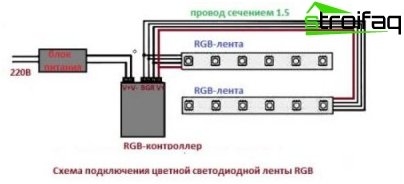
Schematic: Connecting a color RBG LED strip through a controller
To connect a colored LED strip, the use of a controller is mandatory. It allows you to change colors, brightness and implements synchronous shutdown and inclusion of LEDs.
The controller has two terminals: the first for connecting to a power supply, and the second for color channels and a common wire. We connect the wires of the power supply to the controller, then we connect the tape to the last.
If you connect two colored ribbons in parallel, you need to purchase a more powerful power supply and controller. Unfortunately, their weight is also too large to be mounted on a suspended ceiling..
LED lamp installation
Installation of an LED lamp does not require any special knowledge and actions. Almost all LED lamps are manufactured with standard caps, which greatly facilitates the choice of a lamp.
Such lamps can be mounted in any surface. In any case, the manufacturer claims so. Consider the option of installing a lamp in a drywall partition.
Choose a place for installation. Drill a hole with a drill. We take the lamp, pull its wires into the hole, gently squeeze the device to fix.
We insert the necessary lamp into the lamp. We connect the connectors to the distribution block and connect the power.
Versatility and variability of application
LED Strip Lighting
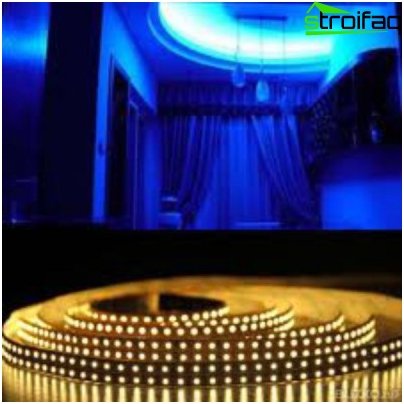
LED strip light can be used to illuminate suspended ceilings and other indoor structures
LED tapes are not yet used as the main lighting in the apartment, yet their power is not large enough. But here, to highlight the work surface in the kitchen, to identify key places in the interior, decorative niches or to decorate multi-level ceilings – these are the tasks for LED strips. Due to their flexibility, they can be laid on curved surfaces of almost any configuration.
LED ceiling lighting
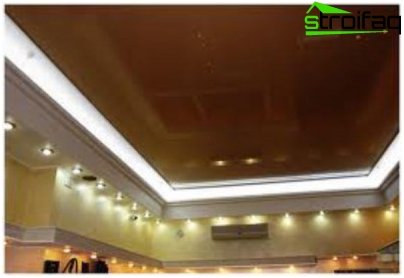
For lighting the ceiling, you can use LED strips and lamps
To illuminate the ceiling, you can use both tapes and LED lights. The only difference is that the tape can provide only a decorative function, and the lamps can significantly illuminate the room or even serve as the main source of light.
Tapes are glued in a niche of the false ceiling so that they are not visible to the naked eye, and are directed upwards to highlight the surface of the ceiling. Lamps are most often mounted in plasterboard false ceilings or Armstrong-type structures and are directed down into the space of the room.
Room lighting options
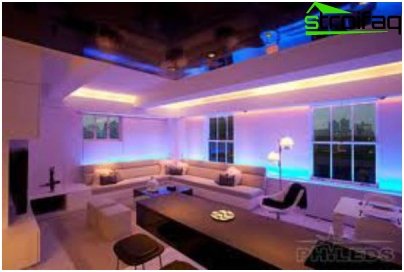
You can also use LED equipment for head lighting the room
To illuminate the room, LED lamps with lamps from 5 to 12 W power are used. How to calculate the required number of fixtures and the luminous flux of each has already been described above. However, there are lamps that are designed to replace old incandescent lamps. Lamps can be installed both in chandeliers, sconces, and in the furniture.
LED lighting in the kitchen
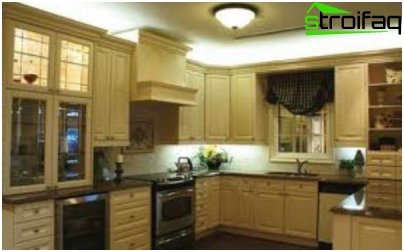
LED lighting in the kitchen: highlighting cabinets outside and inside, as well as the ceiling
Using LED equipment, you can illuminate the work area in the kitchen and the places where people are most often. To do this, you can use the fixtures built into the suspended ceiling. And to illuminate kitchen cabinets, you can use the LED strip glued to the surface. If the lighting is thought out at the design stage, then if desired, you can immediately order a kitchen set with places for fixtures. Moreover, cabinets can be illuminated from the inside. For example, to make sure that the backlight turns on only when the door is opened and turns off when closing.
LEDs in alarm systems
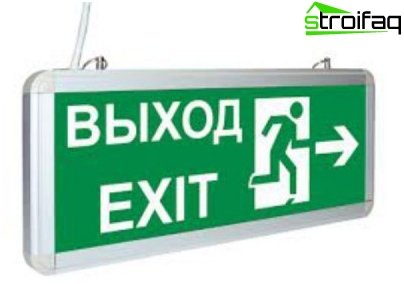
LED equipment used in emergency and emergency lighting
Emergency or emergency lighting is intended to illuminate rooms, buildings, vehicles, if there is a sudden power outage. In this case, it works from a generator. The power of LED lighting is so small that it can significantly save the budget of municipal enterprises, where round-the-clock emergency lighting is required.
Industrial LED Lighting
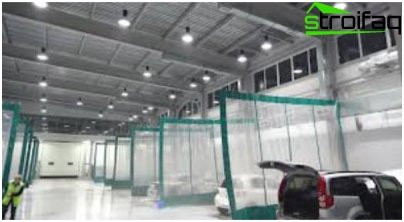
Industrial LED lighting is used in enterprises, car parks, freeways and other places
The use of LED equipment in industrial and industrial premises allows not only to save on energy consumption, but also provides numerous amenities. Firstly, if an incandescent lamp fails, to dismantle it or install a new one, one has to call a specialist and equipment, since they are at an inaccessible height. If LED lamps are used, and their service life is at least 5 years, the need for replacement is extremely rare. In addition to premises, such lamps are used to illuminate embankments, parking lots, cottage villages, motorways and roads.
LED lighting is only picking up pace. It has a lot of advantages: profitability, environmental friendliness, convenient radiation spectrum, durability, light is visible at a far distance, and, of course, design. In addition, the replacement and installation of LED lighting is extremely simple, it can be done independently without the help of specialists.



